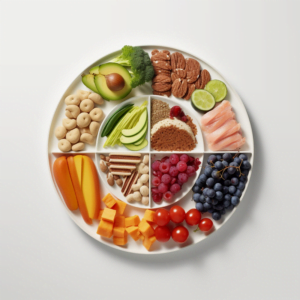Understanding Muscle Loss and Weight Loss
Losing weight seems to be on everyone’s mind as we strive for a healthier lifestyle. However, weight loss is not as simple as it sounds. When you lose weight, you want to make sure you’re not losing muscle mass as well. Losing muscle can lead to a slower metabolism, making it even harder to keep the weight off in the long run. Therefore, it’s important to understand how to lose weight without losing muscle.
Most people assume that weight loss equals fat loss and muscle loss means bulking up. This isn’t true. In fact, muscle loss can occur during weight loss as well as during periods of inactivity, aging, and illness. Understanding the physiology of muscle and how it relates to weight loss is essential in preventing muscle loss while losing weight.
Muscle is essential for maintaining a healthy metabolism and keeping the body functioning properly. Muscle tissue requires more energy to maintain than fat, which means that the more muscle you have, the more calories your body will burn throughout the day. Therefore, losing muscle mass can lead to a slower metabolism, making it harder to lose weight. Also, losing muscle mass can affect negatively the state of your bones (The Ultimate Guide to a Healthy Back).
When you consume fewer calories than what your body needs, it starts tapping into its energy reserves, including muscle mass. This results in muscle loss. In addition, our bodies naturally break down muscle tissue during periods of inactivity, such as sitting for prolonged periods. That’s why it’s crucial to engage in strength training exercises to stimulate muscle growth and prevent muscle loss.
Losing weight can also occur due to illness. When we’re sick or injured, our body requires more energy to heal, which may result in muscle wasting. This can be prevented with protein-rich diets and maintaining an appropriate level of physical activity.
As we age, the process of breaking down muscle tissue accelerates. This process is called sarcopenia and affects both men and women. Sarcopenia can lead to muscle weakness and an increased risk of falls and fractures. Resistance training, also known as weight lifting, can help prevent muscle loss and maintain muscle strength.
Weight loss doesn’t necessarily mean losing muscle. Understanding the physiology of muscle and how it relates to weight loss is essential in preventing muscle loss while losing weight. Maintaining an active lifestyle, including strength training, and eating a balanced diet that is rich in protein, can help preserve muscle mass while losing weight.
Importance of Resistance Training
When it comes to losing weight without losing muscle, resistance training plays a crucial role. Many people believe that cardio exercises are the way to go when it comes to burning fat, but strength training is just as important, if not more so.
The reason for this is simple – muscles need to be worked in order to grow and maintain their mass. When you reduce your caloric intake to lose weight, your body might start to burn muscle for fuel instead of fat. Resistance training can help minimize this loss of muscle mass, ensuring that most of the weight you lose comes from fat stores instead.
Moreover, building muscle can help speed up the metabolic rate, which means you’ll burn more calories throughout the day. This effect is especially important when it comes to weight loss, as it can help create a calorie deficit, which is essential for shedding pounds.
To make resistance training effective, you’ll need to focus on exercises that target multiple muscle groups, such as squats, lunges, and deadlifts. These types of compound exercises require lots of effort and energy, which can help burn calories and trigger muscle growth. It’s also important to increase the weight or resistance gradually as your muscles adapt, as this will keep your body challenged and make your workouts more effective.
It’s also a good idea to mix up your training routine regularly, as doing the same exercises repeatedly can lead to plateaus. This means your body will become used to the stress of the workouts, and your results will slow down or even stop altogether. Changing up your exercises and adding in new ones can keep your body guessing, which can help you make progress toward your weight loss goals.
In addition to a good resistance training program, it’s also essential to fuel your body with the right nutrients. If you don’t eat enough protein, your body won’t have the building blocks it needs to synthesize new muscle tissue. Aim for at least 0.8 grams of protein per pound of body weight each day, and split your protein intake into several meals throughout the day.
Finally, make sure to get adequate rest and recovery between workout sessions. This means taking at least one rest day per week, as well as getting enough sleep and hydration. When you challenge your muscles with resistance training, they need time to rest and repair in order to grow stronger. Neglecting rest and recovery can actually hinder your progress, so make sure to prioritize these aspects of your routine.
In conclusion, resistance training is a crucial component of any weight loss plan that aims to preserve muscle mass. By incorporating compound exercises, increasing resistance gradually, and focusing on proper nutrition and rest, you can make significant progress toward your weight loss and fitness goals.
Strength training and weight loss
When it comes to losing weight without losing muscle, strength training is one of the most effective strategies to achieve that. By engaging in resistance training, you can activate your muscles and help your body burn more calories, even at rest.
Strength training is a form of exercise that involves working with resistance, such as weights or resistance bands. It challenges your muscles to overcome that resistance, leading to muscle growth and development.
One of the benefits of strength training is that it helps you retain your muscle mass while you lose weight. When you reduce your calorie intake to lose weight, your body will naturally start to use your muscle tissue as a source of energy. However, by incorporating strength training into your weight loss program, you can tell your body to preserve the muscle mass and burn mostly fat.
In addition to preserving your muscle mass, strength training can help you burn more calories throughout the day. By building more muscle, your body becomes more metabolically active, which means you burn more calories even when you’re not working out. This is known as your basal metabolic rate (BMR).
To get the most out of your strength training program, you should focus on compound exercises that engage multiple muscle groups, such as squats, deadlifts, and bench presses. These exercises help you build more muscle mass and burn more calories in less time.
It’s also important to gradually increase the intensity of your workouts over time. This will help you build more endurance and lift heavier weights, which leads to more muscle growth and fat loss.
When it comes to weight loss, it’s important to remember that you can’t spot-reduce fat. This means that you can’t just focus on doing ab exercises and expect to lose belly fat. Instead, you should aim to lose weight overall, and strength training can help you achieve that goal.
To maximize your weight loss results, you should combine strength training with cardio exercises, such as running or cycling. Cardio exercises can help you burn more calories, which will create a calorie deficit and ultimately lead to weight loss.
In conclusion, strength training is a valuable tool that can help you lose weight without losing muscle. By engaging in resistance training, you can preserve your muscle mass, increase your metabolism, and burn more calories overall. Remember to focus on compound exercises and gradually increase the intensity of your workouts over time. Combining strength training with cardio exercises can help you achieve your weight loss goals and build a stronger, leaner body.
Related Video
Subscribe to our Newsletter!
First name is optional


